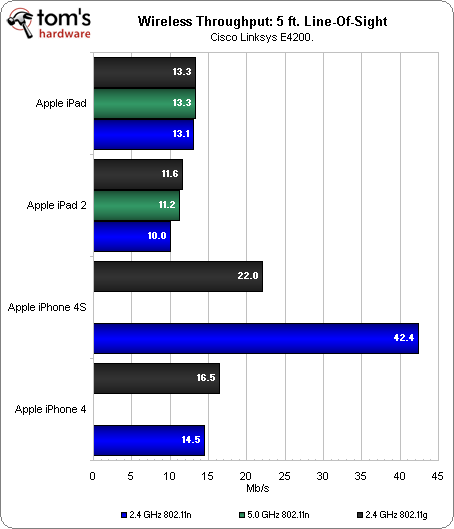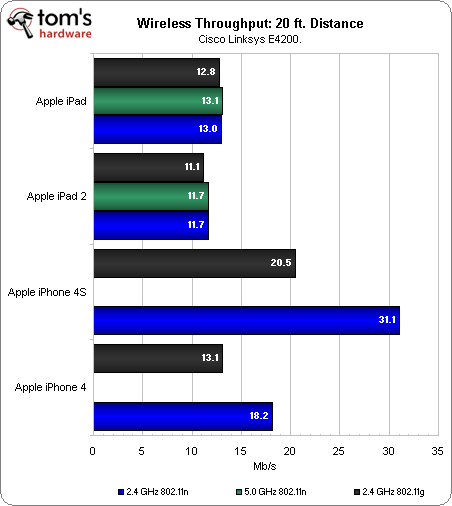Apple iPhone 4S, Part 1: More Horsepower, Better Hardware
Wireless Speeds: Big Improvements In 802.11n
So long as you have enough reception to sustain a phone call, the antenna issue takes a back seat. After all, you're going to be using Wi-Fi whenever possible to avoid taking big chunks out of your cellular data plan as you browse the Web, download apps, and check email. In that case, wireless performance becomes more pertinent. And, in this discipline, the iPhone 4S excels.
Our standard wireless test consists of the following two scenarios:
• Five feet, line-of-sight: The wireless device is set five feet from the router without any obstructions.
• 20 feet, no line-of-sight: The wireless device is set 20 feet from the router and there are three drywall obstructions in our testing environment that reflect the possible degradation you might see in an indoor environment.
Apple's iPhones don't support 5 GHz connectivity, probably because that's simply require another radio sucking down power. However, that functionality really isn't missed because we see a three-fold jump in throughput when the iPhone 4S is connected to a 2.4 GHz 802.11n network.
Get Tom's Hardware's best news and in-depth reviews, straight to your inbox.
Current page: Wireless Speeds: Big Improvements In 802.11n
Prev Page Antenna-Gate: Cellular Signal Woes, Be Gone Next Page First Impressions Of iPhone 4S' New Hardware-
acku maddogjtOn the CPU spec chart, iPhone 4S is mislabeled as iPad 2Reply
Thanks for catching that. Fixed!
Cheers,
Andrew Ku
TomsHardware.com -
dragonsqrrl ...that's what you'll get with an SGX543 MP2. Imagine the performance of the PS Vita with an MP4 and twice the Cortex9 cores.Reply -
jimmysmitty My only question is why is it only being compared to competition in the form of tablets? Why is there no Droid Bionic or the Galaxy SII?Reply
Are we to think the iPhone 4s is equal to a tablet? Especially considering the Bionic has a faster dual core (1GHz Core), more RAM (1GB), Android 2.3.4 (Gingerbread) and is a phone, like the iPhone.
Honestly this review is lacking since it doesn't compare actual phones from other companies (be it Android or WP7) and instead compares it to tablets. -
aznshinobi Why do people think the iPhone 4S is revolutionary or just amazing? The Galaxy S2 is thinner, has a better CPU, and has a much larger screen. To me the 4S is a huge rip-off. iOS5 has a few things they've stolen of Android that people think are "new".Reply -
tramit aznshinobiWhy do people think the iPhone 4S is revolutionary or just amazing? The Galaxy S2 is thinner, has a better CPU, and has a much larger screen. To me the 4S is a huge rip-off. iOS5 has a few things they've stolen of Android that people think are "new".Reply
I don't know about you but I also think it is amazing that a year later any iPhone can hold its value much better then its competing Android counterpart. When I purchased my Nexus S it wasn't to bad, but a couple months later and a huge chunk of the value was lost. Whether you like it or not the iPhone can hold its value due to the large demand.
The GSII some would say is not revolutionary as well compared to the GSI which is the same approach it seems that the iPhone took from the 4 to the 4S. Even though the GSII has amazing hardware, the software still crashes quite often. You would think that with all the power under the hood that it would work more smoothly but it does not. My Nexus S with the most up to date Android software is still buggy at the most annoying times. If I weren't with T-Mobile I would have probably gotten the 4S. Hopefully the Nexus Prime will come to T-Mobile as well and ICS will have fixed even more bugs and work on a seemless and fluid user experience without crashing or having to send an error report. -
acku Reply9521240 said:My only question is why is it only being compared to competition in the form of tablets? Why is there no Droid Bionic or the Galaxy SII?
Are we to think the iPhone 4s is equal to a tablet? Especially considering the Bionic has a faster dual core (1GHz Core), more RAM (1GB), Android 2.3.4 (Gingerbread) and is a phone, like the iPhone.
Honestly this review is lacking since it doesn't compare actual phones from other companies (be it Android or WP7) and instead compares it to tablets.
Agreed. Excellent point. We'll add other smartphone as reference points.
Cheers,
Andrew Ku
TomsHardware.com -
AbdullahG aznshinobiWhy do people think the iPhone 4S is revolutionary or just amazing? The Galaxy S2 is thinner, has a better CPU, and has a much larger screen. To me the 4S is a huge rip-off. iOS5 has a few things they've stolen of Android that people think are "new".I have yet to find someone how thinks the 4S is revolutionary. Innovative, yes, but not revolutionary. And people think iOS5 has new features which Android had simply because people are more aware of the iPhone rather than Android phones. Living in NY, there are a lot of busy routes. One such route which is commonly used to get to Manhattan has a huge billboard advertising the iPhone. Remember, these routes are full of busy people getting to work and so on. The iPhone is going to look appealing to such people. Why? Because they make of majority of the market for smartphones.Reply -
jimmysmitty Reply9521243 said:Agreed. Excellent point. We'll add other smartphone as reference points.
Cheers,
Andrew Ku
TomsHardware.com
I just happen to have gone from a LG Ally to a Droid Bionic (holy crap major difference.
I can give you my sores but I am a bit afraid they might be off since Verizon tend to load the most crap they can.
Overall its not too bad, its got a PowerVR SGX 540.

